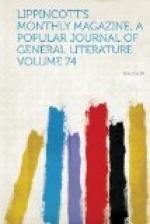All our familiarity with the composition of great pictures does not prevent our becoming bewildered by their size and color on first beholding them. The number of canvases and conflict of hues in a gallery confuse the eye and irritate the nerves. One looks down the interminable corridors, the immense halls, the endless suites of rooms, with growing dismay: as one succeeds another, and the inmost chamber seems farther off as we advance, the nightmare sense of something which is impossible, yet must be done, begins to weigh upon us. And this goes on day after day with a protracted strain upon the limbs, the senses and the brain, until real injury sometimes ensues. After traversing almost without a pause the great art-palaces of Munich, Brussels, Antwerp, The Hague and all the minor ones on the route, on reaching Amsterdam, with its inexhaustible picture-shows, I had got to the point where I sat down amidst the Rembrandts, forced to declare that I would rather look at so much wall-paper of a good pattern. This is utter folly. One cardinal rule in seeking either pleasure or profit is not to tire one’s self. When time is limited and the opportunity may never recur, the temptation is almost overpowering: this is our only chance—we must not lose it. But it is lost if we overtask the perceptions and carry away no idea with us: there is no gain, and positive harm. No one new to galleries should look at pictures for more than an hour together, and I think that one who knows and cares much about them will not wish to do so for more than double that time. We learn by degrees to go through a gallery much more rapidly




